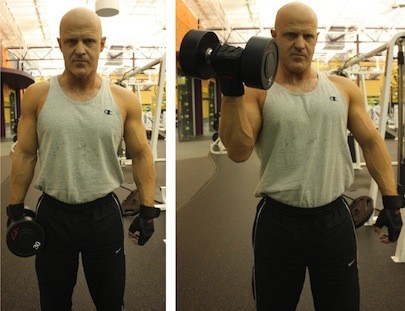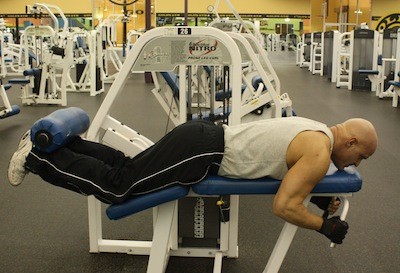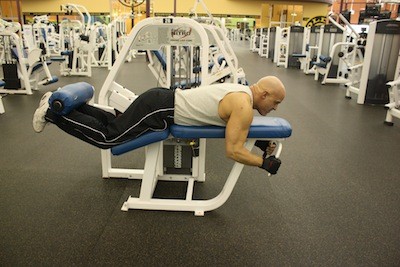This is the in-between season, when the weather is unpredictable—it’s either too hot or too cold outdoors. People start moving their workouts indoors to a gym, but going back to the gym can be dangerous, especially for those who mistakenly think they can pick up where they left off.
“That’s the No. 1 biggest mistake people make: trying to lift too much weight when they start up at the gym again. They think because they were able to bench press 250 pounds before, they should still be able to do it,” says fitness expert John Swenson, 50, whose muscular physique is proof of a good training program.
Proper form is essential for resistance work, but it’s hard to maintain good form if the weight is too heavy. One caveat for lifting: The spine must always be straight, never bent in a forward or backward curve. Never position your weighted upper body so that it’s only being supported by a mere few vertebrae in your lower spine.

RIGHT: CORRECT FORM. // PHOTOS BY WINA STURGEON
Swenson voices an established medical fact: Even though you may be physically able to press or pull or hoist a weight, that doesn’t mean you can really lift it. You may have been active over the summer, but perhaps without using the same muscles, in the same fixed range of motion, used in resistance exercises. Connective tissues—tendons and ligaments—may not be as strong or as flexible as they were previously. You could strain or even tear muscle fibers and connective tissues as you push your body beyond its actual capacity. Worse, there will probably be no warning pain from weakening micro-trauma.
Swenson says the best way to begin again at the gym is to always start with a thorough warm-up. “The older I get, the more I warm up. I use body weight and lightweight machine exercises, especially to warm up joints,” he says.
Watch your balance in a mirror. One limb may be stronger than the other, causing you to lift a bar unevenly or lean to one side when using dumbbells. Any time a lift is performed without a balanced body, it stresses the spine, possibly leading to back pain in the future.
One technique Swenson highly recommends is turning the wrist while doing a curl. This will build forearm muscles and recruit more muscle fibers. Start by holding the dumbbell with your palm toward the leg and the dumbbell ends facing forward and backward; twist the wrist when lifting so the finish position is with palm and fingers pointing to your body, the dumbbell ends facing out to the sides.

- S BY WINA STURGEON
- STARTING & FINISHING POSITION FOR DUMBBELL CURL WITH WRIST SUPINATION
Another common gym mistake is to work out without concentrating on the muscles being used. Learn to feel each muscle as it contracts so you’ll know that you’re doing the exercise correctly, without bringing other muscles in to “help.”
The third-biggest resistance error is using momentum instead of strength to perform a lift. When doing, say, a biceps curl, don’t “swing” the weight upward. Momentum is a poor substitute for actually developing the strength required to do an exercise correctly. When doing the über-important deadlift, bend up and down slowly and deliberately, not letting the weight fall to the floor or using your knees to boost it up again.
It’s also important to know the details of doing an exercise correctly. A common mistake is putting pressure on the knee joint when using the hamstring curl machine. The knee should be just off the bench, so the weight doesn’t put pressure on the patella. In addition, the lifting “roll” should be placed just above the ankle, not in the middle of the calf.

- BY WINA STURGEON
- WRONG TECHNIQUE FOR HAM-CURL MACHINE: NEVER PUT PRESSURE ON YOUR KNEECAP

- BY WINA STURGEON
- RIGHT TECHNIQUE: KEEPING YOUR KNEES OFF THE BENCH PUTS THE PRESSURE ON THE THIGHS
The big problem with machines is that one limb may be doing more work than the other, helping to create muscle imbalances. Swenson recommends using only one limb at a time with machines to make sure each is doing the same amount of work. If you can do 12 reps of 90 pounds with one leg, but only nine reps with the other, you’ll know that you need to do extra work for the weak limb to equalize the strength of both legs.